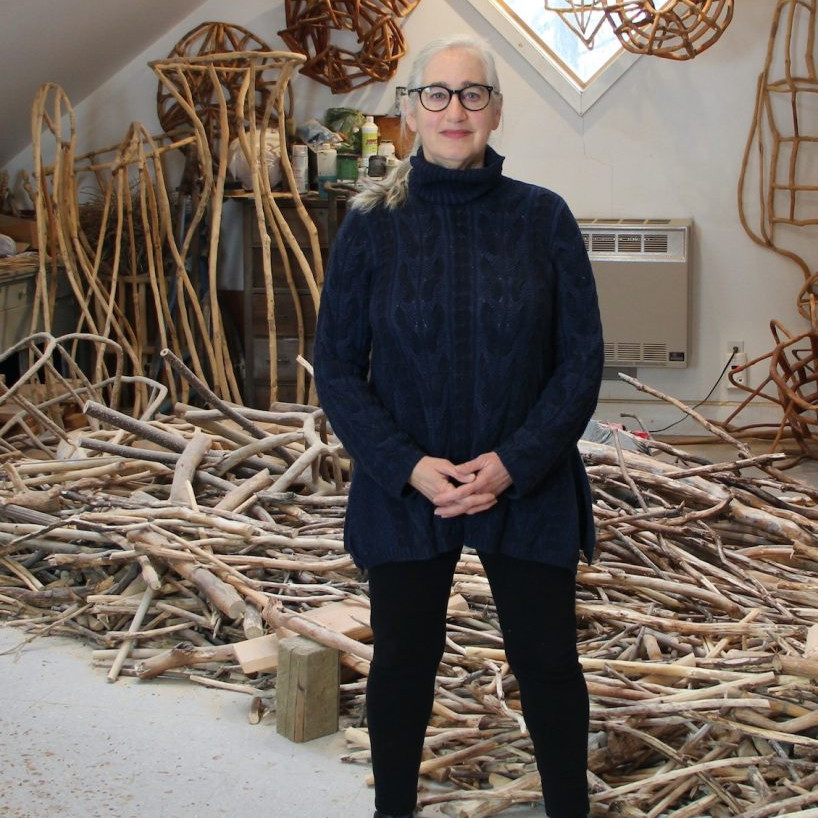Jaynie Crimmins Paper Sculptor
Can you firstly, discuss the importance of the original text in all your pieces?
My source materials are integral to the conceptualization of a project/series. A project called Building a Blue Wall illustrates this very clearly. The Building a Blue Wall project began after the 2016 election in the US. The work is created from shredded non-profit and political solicitations, health care statements as well as magazine articles highlighting issues to protect our freedoms – this work was in support of social justice, women’s health, civil rights for all, science, advocacy, and arts organizations.

Building a Blue Wall 2016-2018
Are they always from the same source or are there pieces with a combination of sources?
My work is very personal to me, and I have been working on projects/series to express my ideas. Because each project is an expression of a specific narrative, if I am using multiple mailings and sources – they get mixed up and end up in the same work. A Field Guide to Getting Lost used one type of catalog [RH catalogs] and In Search of Beauty [pre-pandemic] used individual catalogs for each work. Currently I am using only New Yorker magazines – but not one issue per work.
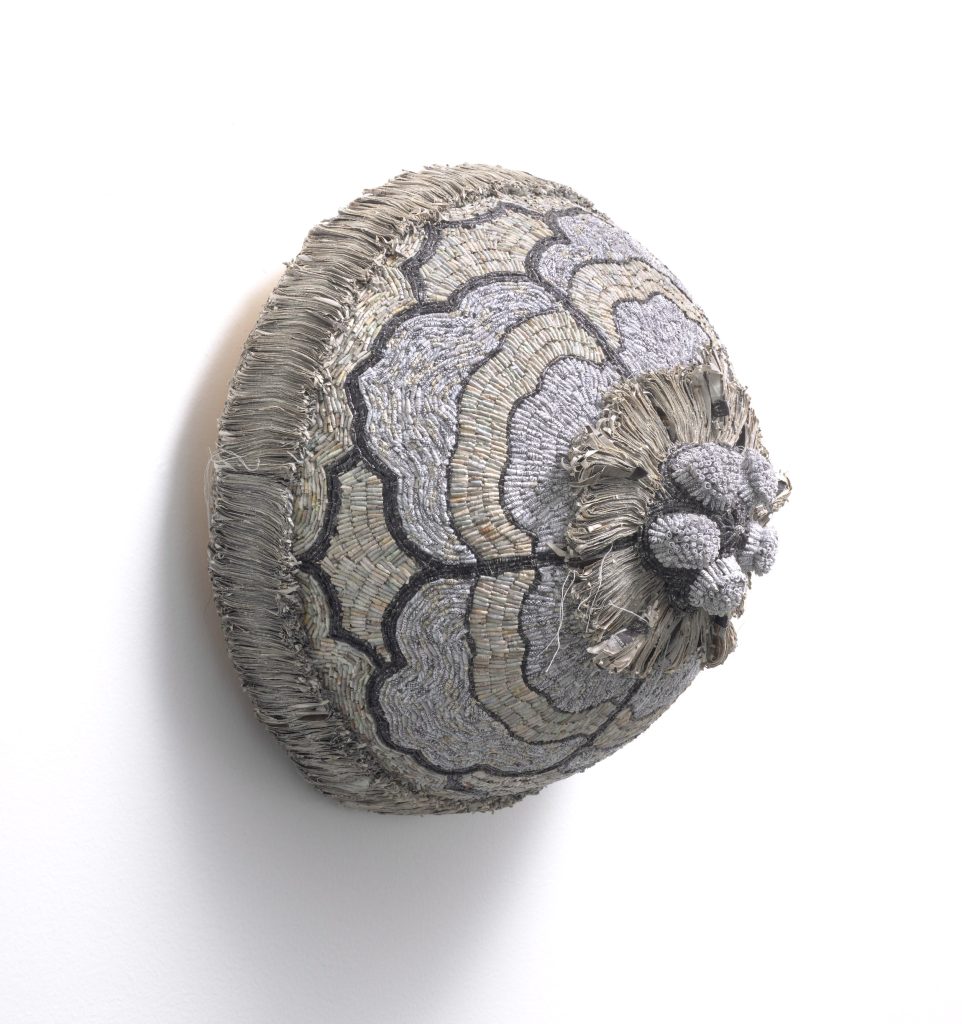
A field Guild to Getting Lost, 12” x 12” x 8” D, shredded RH catalogs, security envelopes, thread, over armature, mounted on wood, side view.
Take us back to your grandparents and how they have influenced your need to collect.
Examining my propensity for collecting leads me directly to my maternal grandparents, particularly my grandmother – the original recycler. Her reasons were not necessarily environmental. The need to save, collect and repurpose things was born from poverty. And that need immigrated to the US from parts of Eastern Europe.
My desire to collect and up-cycle materials originated with my observations of discarded clothing becoming crocheted rugs, old curtains becoming aprons and leftovers becoming the ingredients for new meals.
Nothing was wasted, everything possible was reused. Castoff items became novel and compelling in their potential for metamorphosis. Combining this sensibility with the shredding of junk mail illuminates the physical acts of deconstructing and repurposing.
Can you take us through the process you take from shredding to transformations?
Using a diamond-cut shredder, I shred catalogs, magazines, and security envelopes. Currently I am working with New Yorker Magazines and security envelopes. I manipulate the shreds in various ways – rolling, folding, and sewing. Rolling [which is the only technique I am using now] is done with my non-dominant [right] hand and then individual rolls are placed on a support one-by-one with a tweezer using my left hand, applying an archival adhesive called Lineco. It is a painstaking and meditative process. Steps to roll a shred
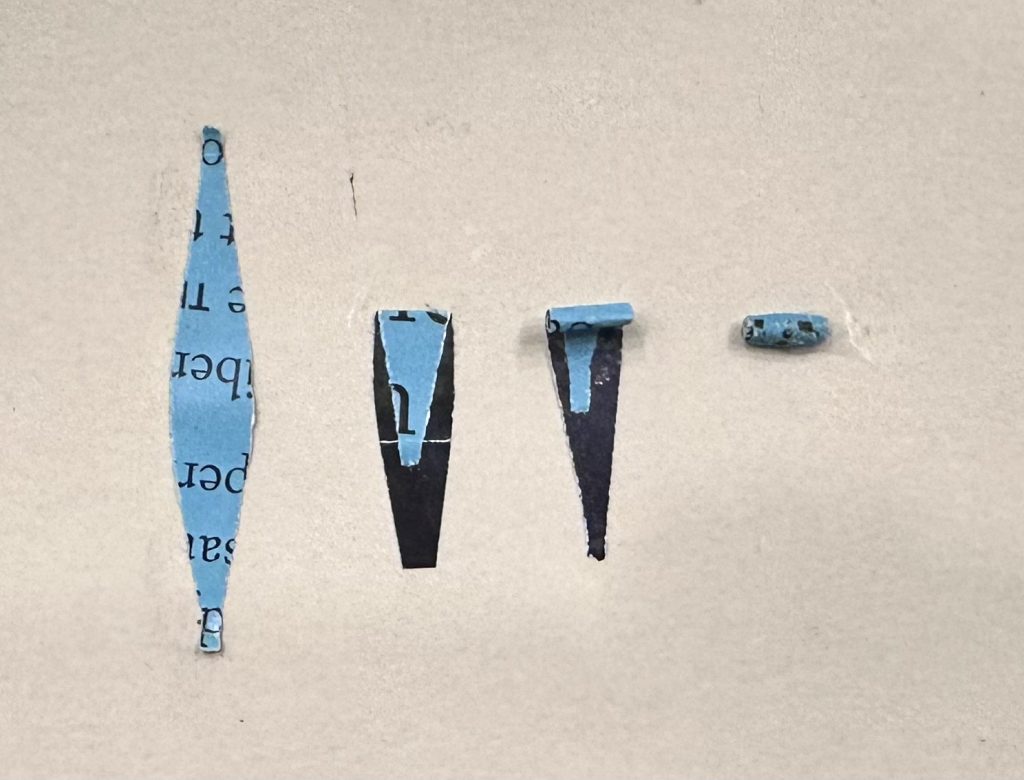
How do you decide on the balance and symmetry of each piece?
My work looks like it is following a sketch or plan, yet it grows organically. In my mind, I am planting a seed when I start my work in the center. From this “seed”, the entire work takes form. I am interested in symmetry but do not really measure or layout the work prior to beginning – therefore I identify my work as applying approximate symmetry. While I am working, I sometimes sketch on the armature, and then I generally ignore what was drawn!
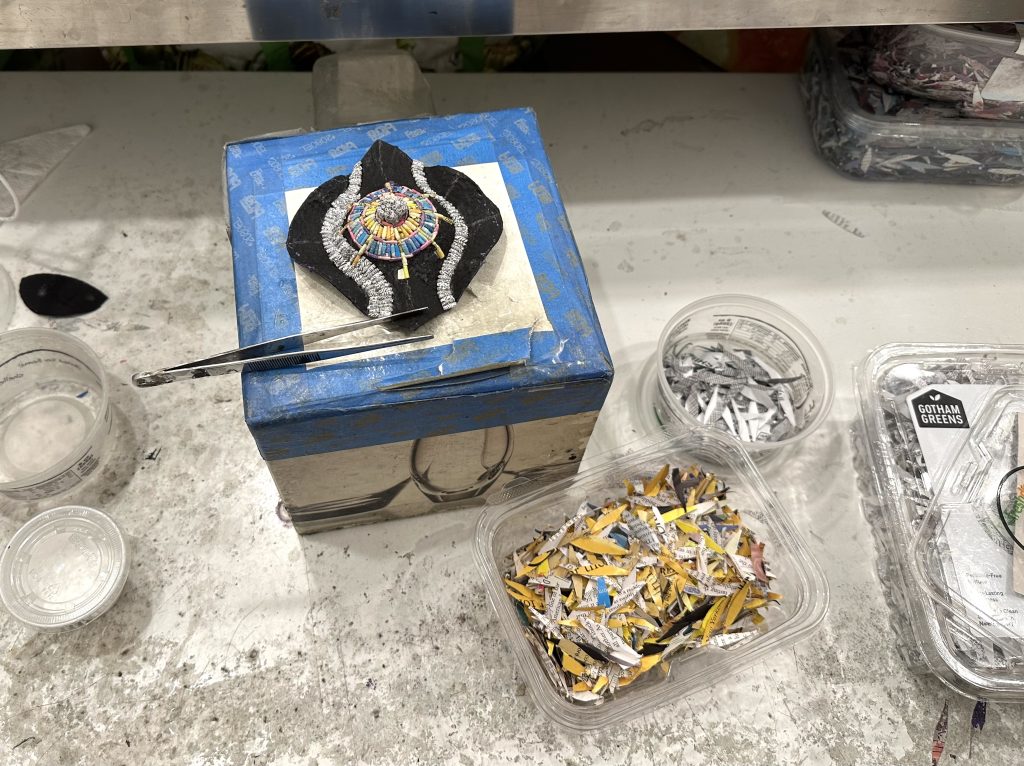
How important is the colour of the original printing in your work?
My palette is derived from the printed colors of the materials I am using. Prior to shredding the magazines or catalogs, I create separate piles of colors, much the same way painters organize their paint palette. I shred the colors individually, storing colors that are not part of the selected palette for that work. The various patterns, from the inside of security envelopes, are shredded as well.
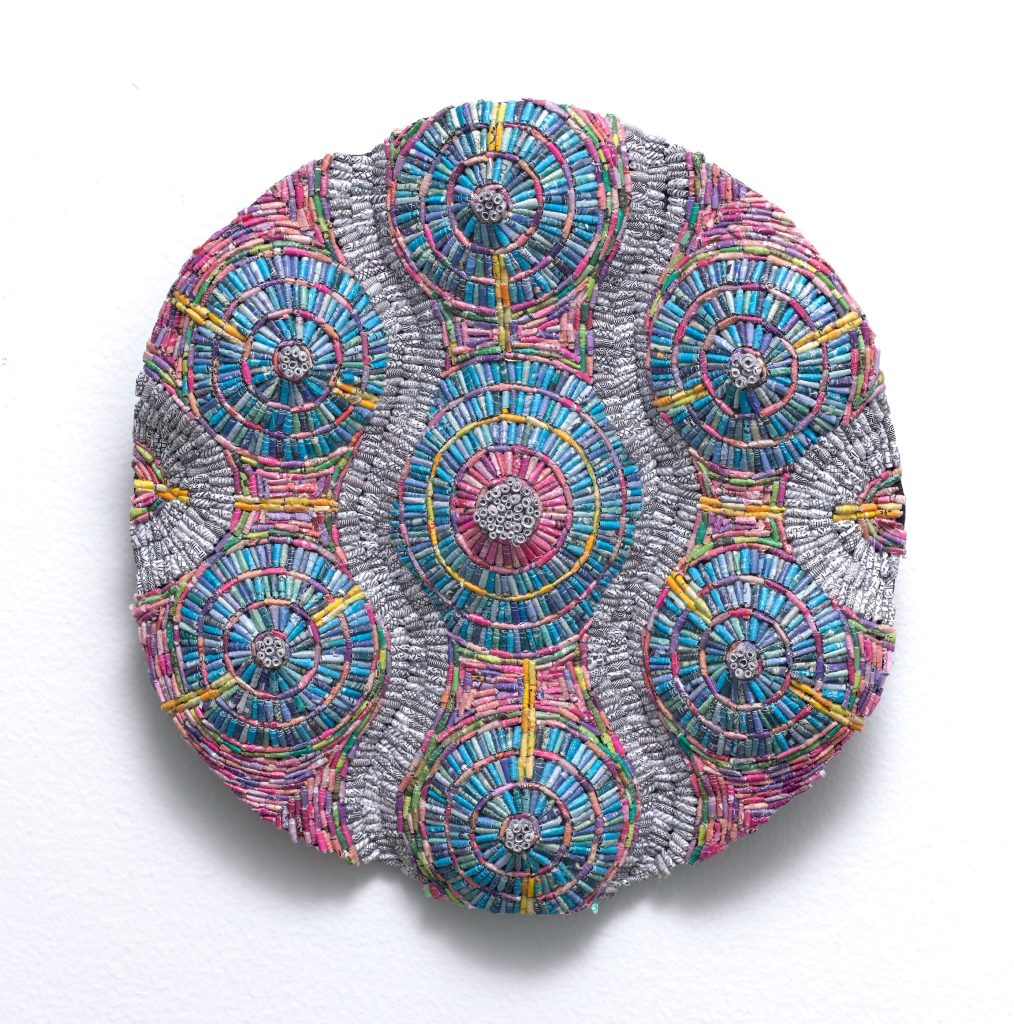 Equanimity #14 shredded New Yorker magazines and security envelopes over post consumer armature, 8 x 8 x 2.5D
Equanimity #14 shredded New Yorker magazines and security envelopes over post consumer armature, 8 x 8 x 2.5D
Discuss the way you use different dimensions in your work?
The surfaces of my work are textural, and the work is generally installed as wall reliefs. Until someone called me a sculptor, I never thought of myself in that way. There has always been an element of projection in my works whether created by the materials themselves or the armatures used. For my current series, Equanimity, the armatures used are from fruit packing purple cardboard inserts. These surfaces have undulating convex/concave surfaces that represent the waves of my breath during mediation.
Comment on how single and multiple pieces as hung for sale.
I am very particular about the installation of my work in certain instances. I like to group them in various configurations, mixing large and small work, framed and unframed. I have also been very lucky to have worked with and continue to work with incredible, intelligent, and talented dealers and curators. In those instances, I am not involved at all in how the work is installed, leaving it to their discretion.

Equanimity, installed at The Clemente, NYC
When and how did you first produce this idea?
In 2009, when the US was experiencing a recession, I was reading many op ed columns by [former NY Times columnist] Bob Herbert. He wrote movingly about the terrible circumstances, [including losing employment, underwater mortgages, etc.] many people were experiencing at that time. While I was personally fortunate enough not to be adversely affected, the economic decline of average Americans was deeply troubling.
I began to shred my financial statements including bank statements, bills, and other financial documents. I used beeswax as a coating to entrap this deconstructed information as if in amber – to preserve for perpetuity. The projects were called: Home Economics and Borrowing from the Future. From these initial series, I began adding more source materials to express personal ideas and replace their messages with my own narratives. I also freed the shreds from the wax, allowing the newly introduced materials, with color, to be exposed.
Equanimity #10 shredded New Yorker magazines and security envelopes over post consumer armature, 12 x12 x 1.5D
Comment on how your understanding, of paper art, has changed since you began. – (Seen as art not a craft.)
As the definition of fine art has shifted and morphed, paper arts have been re-categorized and celebrated as fine art. This evolution is inspired by the increased recognition of the technical skill, artistic vision, and conceptual depth inherent in paper arts. Paper artists have expanded the possibilities of the medium using found, manufactured and handmade paper – all in the service of creating meaningful and elevated art objects.
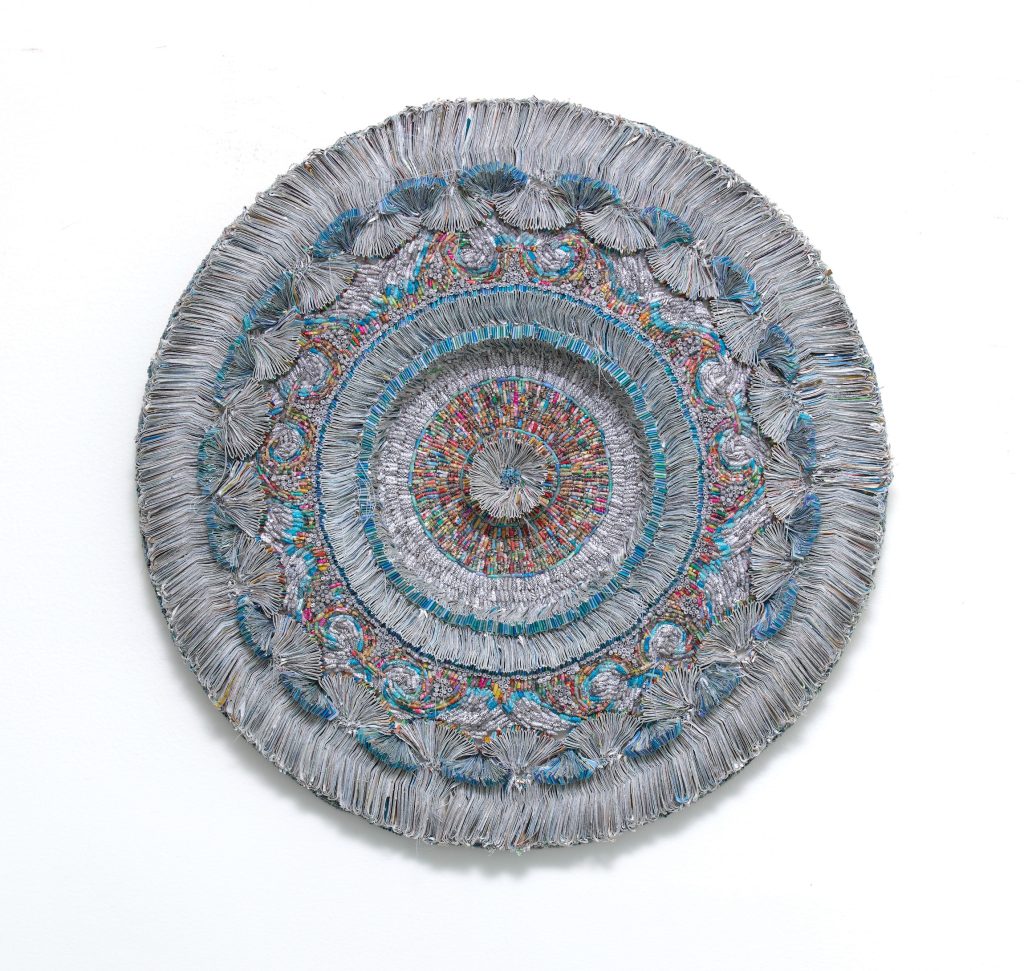 In Search of Beauty #11
In Search of Beauty #11
Tell us about your up coming exhibition, ‘With Every Fibre.’
I am excited to participate in the group show With Ever Fiber at Greenwich Academy’s Luchsinger Gallery in Greenwich, CT. It is the first time I am exhibiting at a private day school and am looking forward to having my work introduced to a new audience and interacting with the students. The work included in this show is from my In Search of Beauty series which incorporates sewing.
The curator Kristen Erikson states: “The works in this exhibition largely transcend artistic categories, instead fusing elements of weaving, sewing, painting, sculpting, and mathematics into three-dimensional sculptural forms. Found materials mingle with natural and synthetic. dyes and fibers. Patterns are developed, repeated, and distorted, sometimes evoking recognizable forms like fossils, archeological fragments, maps, or constellations.”
Are you ever given commissions along with boxes of related papers?
I am working on a commission now and have had prior commissions but only one in which I was given specific shredded documents to work with. It was a birthday gift for a collector’s sister. The shreds were financial papers from their [deceased] mother, that, to the client, represented their single mother’s strength and independence.
How did Covid effect your art practice?
Covid had a huge effect on my art practice. For one thing, I started a meditation practice which influenced my work [and will be discussed later on]. One of the reasons for beginning to meditate was that I live around the corner from Lenox Hill Hospital in Manhattan. During the pandemic, there were refrigerator trucks parked around the corner from my apartment to house the overflow of Covid victims’ bodies. It was extremely upsetting, I would say traumatic, especially since there was a segment of the US population that was denying the pandemic was real. I needed to calm down.
Also, my pre-pandemic studios, were in a neighborhood accessible to me by train in Brooklyn, NY called Bushwick. It is a thriving artist community, and I met many friends there. When it was clear we were going into lockdown, I brought enough supplies home with me for about a week or two. I do not own a car, and at the time, public transportation was being used mostly by essential workers. After several months, the realization that the pandemic was extremely serious and dangerous, I decided to move my studio into Manhattan to a neighborhood that I could walk to from my apartment – East Harlem. At first, I felt displaced, but eventually I began to build a new community of artists scattered around that part of the city.

Equanimity #3 10” x 12” x 1”D, shredded New Yorker magazines and security envelopes over post consumer armature.
You have also exhibited beyond the US – comment on one experience.
A friend had recommended my work for the Sharjah Biennial Arts Festival in the United Arab Emirates. I submitted images and a statement based on their theme and the work was accepted into the exhibition! It was an incredible experience. I met artists from all over the world and was so honored to be shown with creatives of that high caliber. The Biennial staff was amazing – organizing trips, meals, everything. Each artist was given a space in which to install their work at several venues – indoors and outdoors. The experience was truly transformative.
Comment on how you combine meditation and creativity, in your art.
I began to practice meditation during the pandemic – focusing on the breath and specific phrases. Meditating during uncertain times helped me to remain present and try to find some balance in my life. The definition of equanimity is: mental calmness, composure, and evenness of temper, especially in a difficult situation.
In addition to meditation, creating can also be a meditative process. Working with my materials enables me to connect with the present moment and immerse myself in the creative process.
Equanimity, as a body of work, embraces the notion that the waves in each piece embody my breath and state of mind, while the use of New Yorker magazines aims to capture both the struggles and joys that challenge me to keep a calm state of mind.
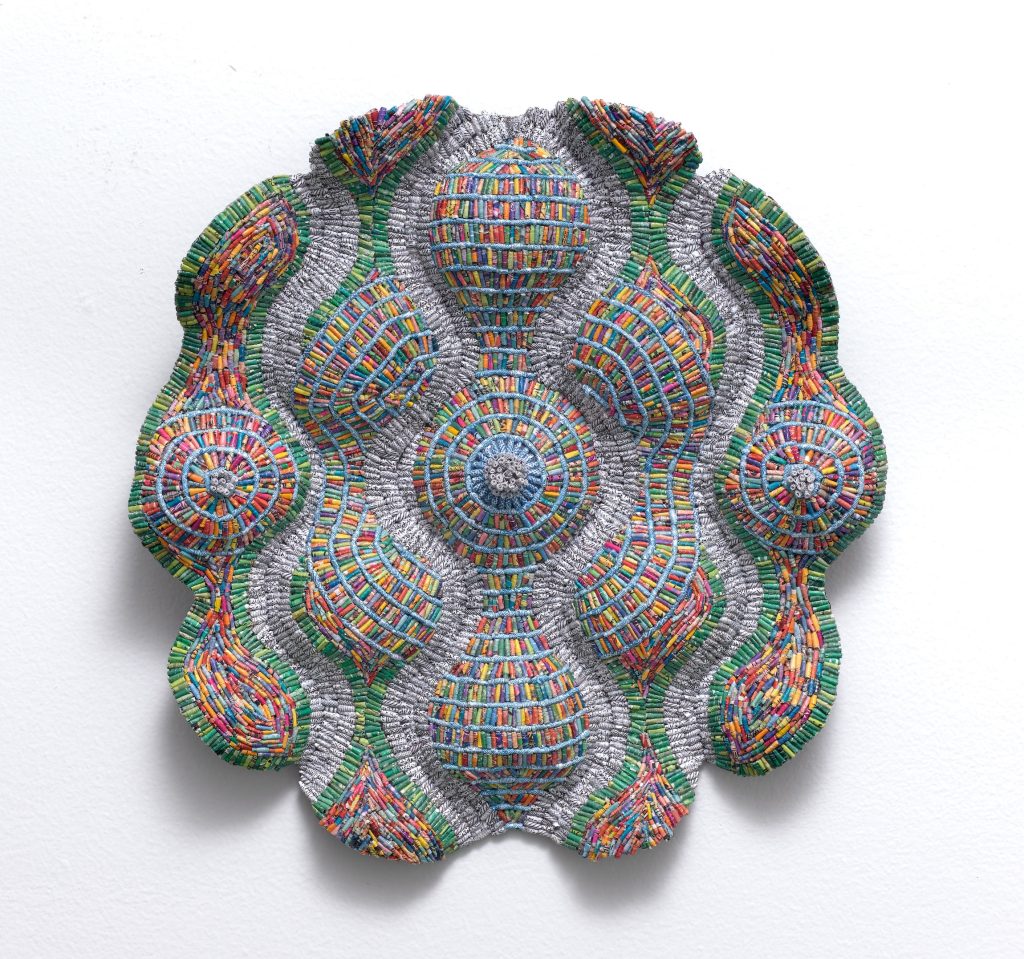 Equanimity #5, 2021, shredded New Yorker magazine images, security envelopes over up-cycled armature, 12 x12 x1.5 D.
Equanimity #5, 2021, shredded New Yorker magazine images, security envelopes over up-cycled armature, 12 x12 x1.5 D.
Contacts:
Jaynie Crimmins
Interview by Deborah Blakeley, February, 2024
Images on this page are all rights reserved by Jaynie Crimmins
Think a colleague or friend could benefit from this interview?
Knowledge is one of the biggest assets in any business. So why not forward this on to your friends and colleagues so they too can start taking advantage of the insightful information the artist has given?
Other artists you may be interested in:





